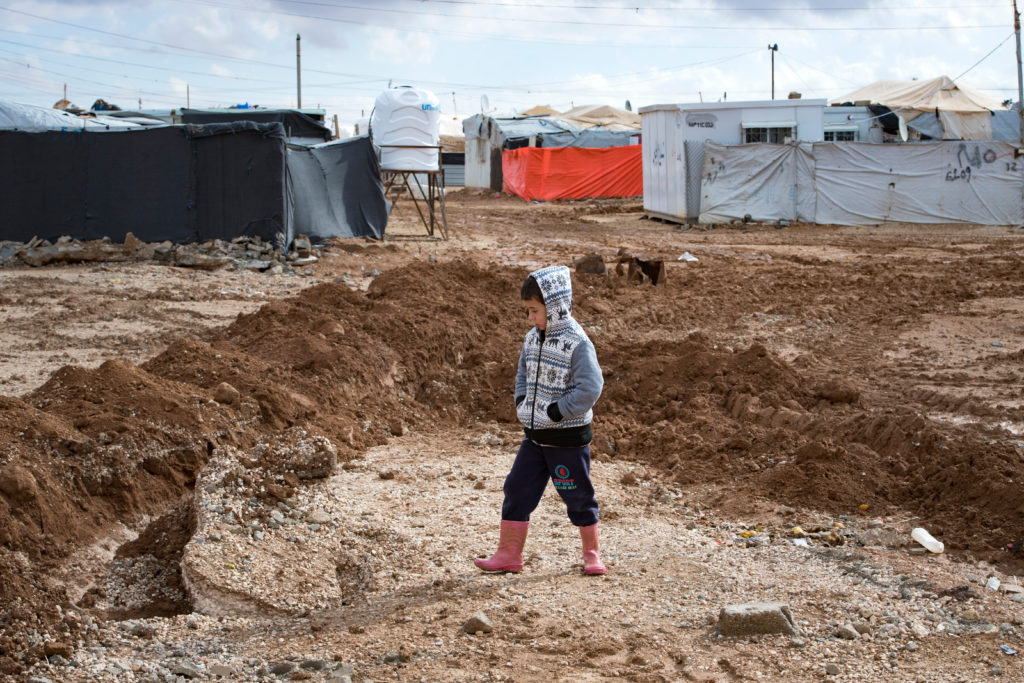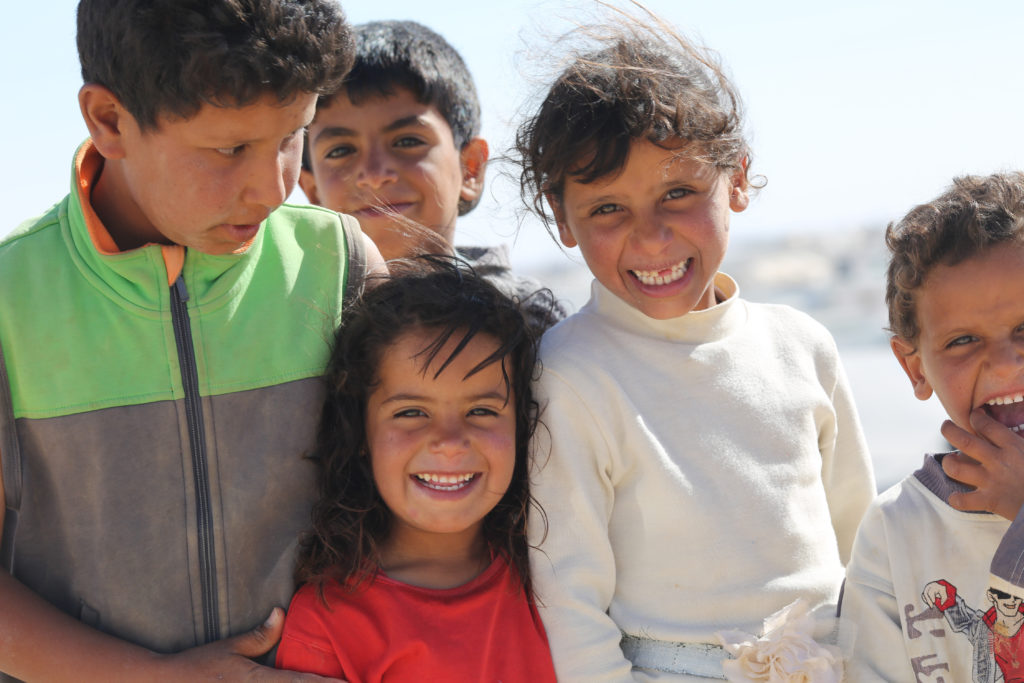The Za’atari refugee camp is the largest refugee center in the Middle East and one of the largest in the world (DW, 2022). According to United Nations statistics, more than half of the 81,000 refugees living in the Za’atari camp are minors (Aljazeera, 2016). Children within the camp are subjected to violations of their fundamental rights and severe deprivation of their fundamental requirements. Consequently, fun childhood’s aspects are restricted only to specific zones provided by humanitarian organizations.
Za’atari refugee camp – unsafe environment for children
The Za’atari refugee camp, located 10 kilometers east of Mafraq, was established on July 28, 2012, in Jordan to accommodate Syrians displaced by the ongoing conflict in Syria (Wikipedia, 2023). The Za’atari camp is the largest refugee center in the region of the Middle East and one of the largest in the globe (DW, 2022). More than half of the 81,000 refugees residing in the Za’atari camp are minors, according to United Nations figures (Aljazeera, 2016). More than 20,000 births have been registered in Za’atari, which is equivalent to approximately 40 births per week (Carlisle, 2022).
The most severe violation of children’s rights in the Za’atari refugee camp is the unsafe environment itself, which contradicts Article 22 of the United Nations Convention on the Rights of the Child, which states that children should receive assistance and protection in refugee zones. Children in the Za’atari camp are exposed to security incidents, prompting Jordanian authorities to increase the number of security personnel in the camp and establish a “community police” (Aljazeera, 2016). In addition, this insecure environment lacks the optimal setting for developing their personalities and tracking their development (Alarabiya, 2013).
Violations of children’s fundamental rights in the Za’atari refugee camp
The most significant violation of children’s rights in the Za’atari camp is the violation of their right to health. Children lack sanitation due to a lack of access to pure water, detergent, and bathing gels. Furthermore, inadequate nutrition is another aspect of health rights violations. Specialists have estimated that the nutritional value of children is insufficient, causing parents to be concerned about potential diseases in the absence of required vaccinations (Alarabiya, 2013).
Water is a valuable resource in the camp. It is estimated that 30 percent of surveyed households in Za’atari reported that the water supply did not meet their requirements (Carlisle, 2022). Electricity is an additional aspect of the difficulties. In 2017, a solar plant was constructed to power the camp, but its capacity was insufficient to satisfy the demands of all residents for more than 11.5 hours per day. In recent months, UNHCR has been forced to reduce this to nine hours per day in order to manage the increased electricity costs (UNHCR, 2022).
The right to education is also not a priority for many relief and humanitarian aid organizations (Aljazeera, 2016). The camp’s educational services are provided by only 15 institutions, which serve 81 000 refugees (Summers, 2017). According to estimates, 78% of children do not attend school, while the remaining children complain of corporal punishment and congestion (Alarabiya, 2013).
Mental challenges faced by children in the Za’atari camp

In addition to physical challenges, the children in Za’atari also face psychological obstacles. More than 60,000 children in the Za’atari camp have numerous issues, the most significant of which is the deterioration of their mental health (Al-aljoumhouria, 2013).
In addition, medical care is severely lacking due to the shortage of qualified medical personnel and pharmaceuticals (Aljazeera, 2016). According to UNCHR, there are only eight medical facilities that treat 81,000 individuals free of charge. Each month, approximately 250 medical consultations are provided (UNCHR, 2022).
Child labour has also been seen as a violation of children’s fundamental rights in the Za’atari camp, which prevents them from reaching their full developmental potential. In their worst manifestations, which are also prevalent in the Za’atari camp, they imperil the physical, mental, and emotional health as well as the lives of children.
In 2014, the Jordan Office of Save the Children International (SCI) and UNICEF Jordan conducted a comprehensive study on the extremely visible phenomenon of child labour among Za’atari refugees. The survey, which included 7- to 17-year-old adolescents from 518 households, showed that 69% of the children at the camp have worked as adults. In addition, detailed and specific recommendations for short-, medium-, and long-term requirements are provided in response to the survey’s findings (Save the Children, 2014).
A substantial lack of international assistance
An additional significant obstacle to implementing the basic rights of children in the camp is the discernible decline in international assistance. Despite the fact that international organizations concerned with the welfare of children exert considerable effort, their efforts are insufficient in comparison to the large number of children in the camp.
Families of refugees in the camps are entirely reliant on aid, while the Jordanian Ministry of Planning and International Cooperation reports a substantial reduction in financing for the country’s response plan to the Syrian crisis.
In 2016, 62% of the requirements were met, according to official statistics, whereas in 2019, that percentage dropped to 50%. In 2021, it changed once more, falling to 30% (Fodelat, 2023). In the absence of international aid, a country with limited resources like Jordan will be unable to address rising rates of hunger, poverty, child labour, and security issues.
“Safe spaces” – the only joyful zone for children in the camp
Within the camp, humanitarian organizations have established “safe spaces” for children to live their cheerful lives. Volunteers engaged in leisurely pursuits such as drawing and playing. Children need these tools to develop resilience, immunity, and adaptability (Borges, 2019). It is the first playground for children in the Za’atari refugee camp that is accessible to all. The playground has been designed and outfitted to accommodate both children with and without disabilities playing together.
In addition, humanitarian organizations work in these zones to support Syrian refugee artists by providing capacity-building workshops and opportunities to work in their field, as well as to engage children in the camp in discussions and art-making about Syrian social issues, their longing to return to Syria, their hopes for the future, and their plight as refugees.
Furthermore, children collaborate on arts-based initiatives aimed at reducing tensions and fostering social cohesion in these spaces. Hundreds of children have had the opportunity to contribute their own creativity to murals in refugee shelters and host communities, bringing colour and life to a desolate place.
What can be done to improve the conditions of children in the Za’tari camp?
The international community should endorse Jordan’s government’s commitment to assisting children in the camp. Health should be emphasised via the provision of promotional and preventive health services, including sufficient mental health care, the expansion of medical facilities and specialists, and the provision of required vaccinations.
While assisting children, humanitarian organisations should also emphasise education by assisting local authorities in establishing new facilities, increasing the number of competent educational experts and assistants, and increasing the number of kindergarten classes. Early infancy is an essential time for children to develop key social and cognitive abilities that will serve them well as they grow. In addition to expanding “safe spaces” and providing them with a range of activities where children may interact, play, and heal from traumatic occurrences.
Humanium has long advocated for a society in which children’s rights are acknowledged and protected and in which no child is ever subjected to violation or deprivation. Humanium is working diligently to promote a safer and brighter future for the refugee children by promoting awareness of their rights and the need to end child rights violations.

In addition, Humanium works tirelessly to collect aid around the world in order to alleviate their distress and provide them with a nurturing environment. Because of your assistance, the outcome will change. Please consider making a donation, sponsoring a child, or volunteering with us as you help us make the world a better place for children. You’ve been a great help to us!
Written by Malak Rababa
References:
Al-aljoumhouria. (2013, August 10). The children of Zaatari camp suffer from the deterioration of their psychological state. Retrieved from Aljoumhouria at https://www.aljoumhouria.com/ar/news/-, accessed on May 14, 2023.
Alarabiya. (2013, July 30). Zaatari camp: 60,000 children suffer from health and psychological problems. Retrieved from Alarabiya at https://www.alarabiya.net/arab-, accessed on May 14, 2023.
Aljazeera. (2016, March 13). Zaatari refugee camp: the largest refugee camp in the Arab world and the second in the world. Retrieved from Aljazeera at https://www.aljazeera.net/encyclopedia/, accessed on May 14, 2023.
Amman Net. (2013, May 8). Who deprives Zaatari children of education?. Retrieved from Amman Net at https://ammannet.net/, accessed on May 14, 20123.
Borges, A., & Abou Chacra, & R. (2019, January 31). Zaatari Camp: How do Syrian refugee children live, and do they need a “safe area.” Retrieved from Arabic Euro News at https://arabic.euronews.com/2019/01/31/zaatari-s, accessed on May 14, 2023.
Carlisle, L. (2022, July 29). Jordan’s Za’atari refugee camp: 10 facts at 10 years. Retrieved from UNHCR at https://www.unhcr.org/ar/, accessed on May 29, 2023.
DW. (2022, October 3). They spent their lives in the Zaatari camp, Syrian children ask: What is Syria.Retrieved from DW at https://www.dw.com/ar/%, accessed on May 14, 2023.
Fodelat, A. (2023, July 24). Funding only 10% of its needs: 10 years of establishing the “Zaatari” camp, and donors turning their backs. Retrieved from Aljazeera at https://www.aljazeera.net, accessed on May 14, 2023.
Joelartista. (n.d.). The Syrian Refugee art initiative. Retrieved from Joelartista at https://joelartista.com/syrian-refugees, accessed on May 15, 2023.
McKeever, C. (2018, December 20). Inclusive playground opens in Za’atari refugee camp. Retrieved from UNICEF at https://www.unicef.org/jordan/stories/inclusive, accessed on May 15, 2023.
Petra. (2021, March 23). Launching an initiative to support the children and families of the Zaatari camp. Retrieved from Petra at https://petra.gov.jo/Include/InnerPage.jsp?ID=58961&la, accessed on May 14, 2023.
Savethechildren. (2014). Baseline Assessment of Child Labour among Syrian Refugees in Za’atari Refugee Camp – Jordan. Retrieved from Save the children at https://resourcecentre.savethechildren.net, accessed on May 15, 2023.
Slemrod, A. (Ed.). (2022, November 22). For Syrians in Jordan’s Za’atari camp, aid money doesn’t buy what it used to. Retrieved from The New Humanitarian at https://www.thenewhumanitarian.org/, accessed on May 15, 2023.
Summers, H. (2017, July 29). Thousands of Syrian children in Jordan’s Za’atari camp missing out on education. Retrieved from The Guardian at https://www.theguardian.com/global-development/2017/ju, accessed on May 15, 2023.
UNCRC. (1989, November 20). Convention on the Rights of the Child. Retrieved from OHCHR at https://www.ohchr.org/en/instruments, accessed on May 15, 2023.
UNHCR. (2022, July 29). Durable solutions required for Syrian refugees in Jordan as Za’atari camp turns 10. Retrieved from UNHCR at https://www.unhcr.org/ar/62e3b82b4, accessed on May 15, 2023.
Unicef. (2019, March 12). Best start to education for thousands of preschool children in Za’atari and Azraq refugee camps. Retrieved from UNICEF at https://www.unicef.org/jordan/, accessed on May 15, 2023.
WHO. (n.d.). The children of Al Zaatari. Retrieved from EMRO at https://www.emro.who.int/jor/jordan-news, accessed on May 15, 2023.
Wikipedia. (2023). Zaatari refugee camp. Retrieved from Wikipedia at https://en.m.wikipedia.org/wiki/Zaatari_refugee_camp, accessed on May 15, 2023.


